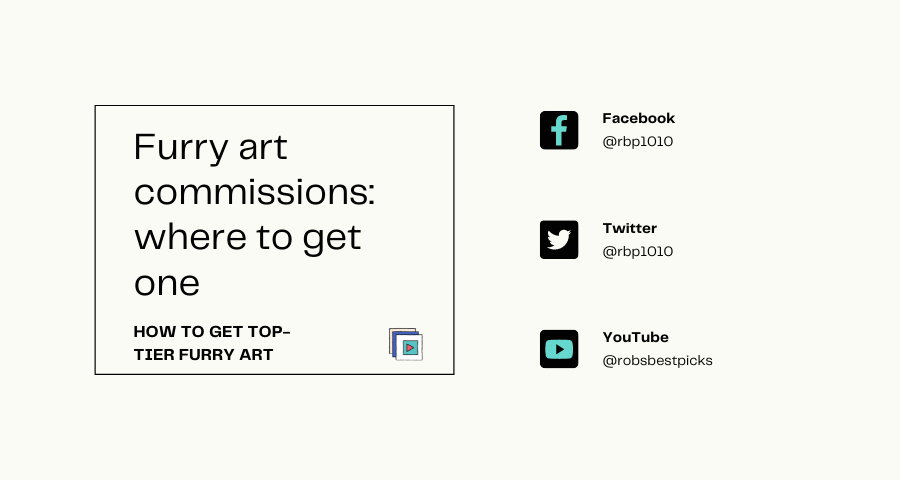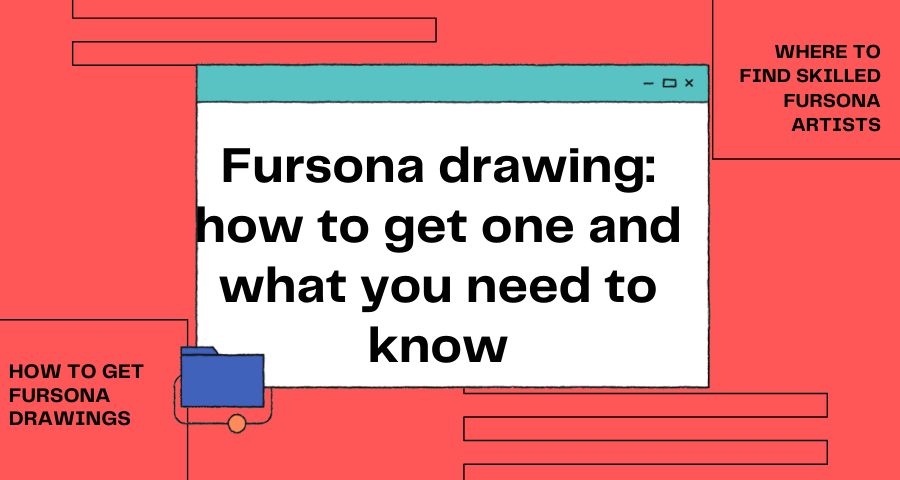Cartoons are fun. Just ask any kid (or adult like me). They’re a way to present otherwise complex topics in easy to understand, lighthearted and perhaps, more importantly, engaging formats. Call them mini engagement engines, and you won’t be wrong.
But you’re a business owner, maybe a writer but certainly not a cartoonist. How do you infuse some cartoons into your content or business? I talk about that and more in this how to hire a cartoonist guide.
The hiring pitfall
It’s easy to think that anyone who bears the cartoonist title should be able to recreate your favorite cartoon character, but that’s not how it works. Cartoonists have unique styles, and most of the content they produce will mirror that style.
Before hiring a cartoonist, you want to get a hang of their art style and then gauge it to see if it fits with your needs, and speaking about needs;
First things first, determine your needs.
Why do you need a cartoon? Is it to tell a story, paint a better picture, expand on details or simply to make whatever you’re adding it to more attractive in the eyes of the viewer? Your needs determine which cartoon style will work best for you and which artist you should hire for the job.
Obviously, some cartoonists might know how to work with one, two or three cartoon styles, but you’re better off hiring them for the one they’re best at. You’re better off hiring a cartoonist who’s an expert at one style than a jack of all trades who’s likely to be a master of no style.
At this point, it’s also a good idea to size up your budget and how much are you willing to pay, as that will be important as well when you decide to select a cartoonist.
The types of cartoons
Cartoons come in different forms – even anime is a form of cartoon depending on who you ask – but we’re just going to focus on the forms that fit the traditional definition of cartoons. They include:
Illustrations

Illustrations are cartoons that describe specific scenarios or ideas in a fun, simple and usually direct manner. They say putting words to paper – with illustration; it’s putting ideas as art to paper. Illustrations can combine text and graphic elements, but the latter usually predominates the former. Texts serve as an expansion of the idea conveyed by the graphical elements in most illustrations.
What’s it good for
- Brand storytelling
- marketing material
- Advertorials
- Header images for publications
- In-line explainers for published content
Political cartoons (editorials)
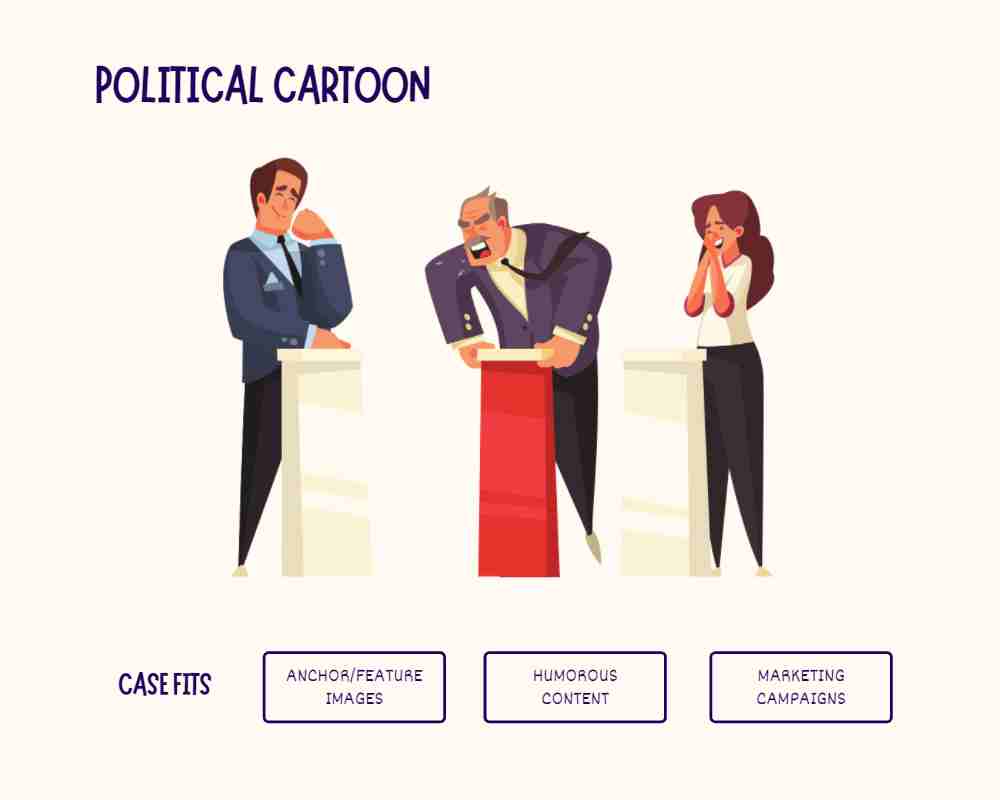
Editorials or political cartoons are drawings with a political undertone. They’re created to convey a message, usually in an underhand and often indirect way. The art style here is usually caricature-like, and like illustrations, it’s usually a mix of graphics and text. Editorials usually go into newspaper publications, magazines (online or offline) or periodicals.
What’s it good for
- As anchors and feature images in newspaper publications
- Political humor and political content
Gag cartoons
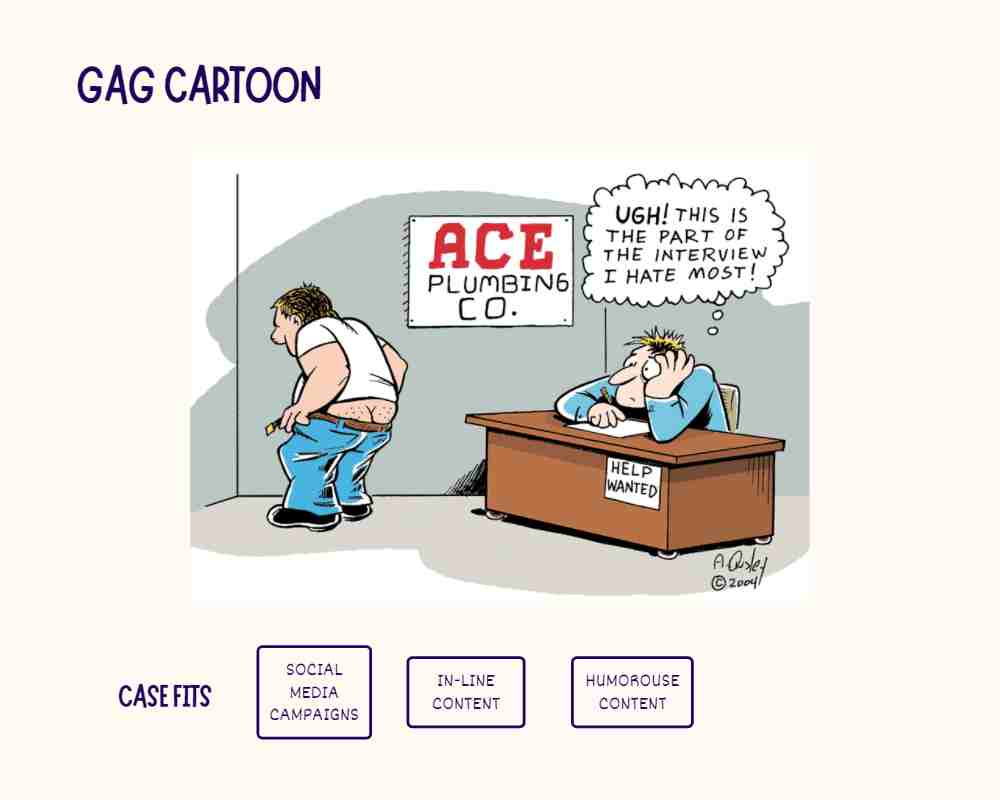
Gag cartoons are funny cartoons usually created for entertainment purposes. They make fun of an idea, situation, scenario, place or even person.
The best ones are lighthearted (compared to political cartoons, for instance) and come with accompanying text which serves to emphasize the ‘gag’ or joke. Gag cartoons are insanely popular. If you frequent any social media platform, you probably come across one or two every other day.
What’s it good for
- Social media campaigns
- Humor content for brand storytelling
- Humor content for brand positioning
- In-line content for improving engagement and quality of published material
Comic strips
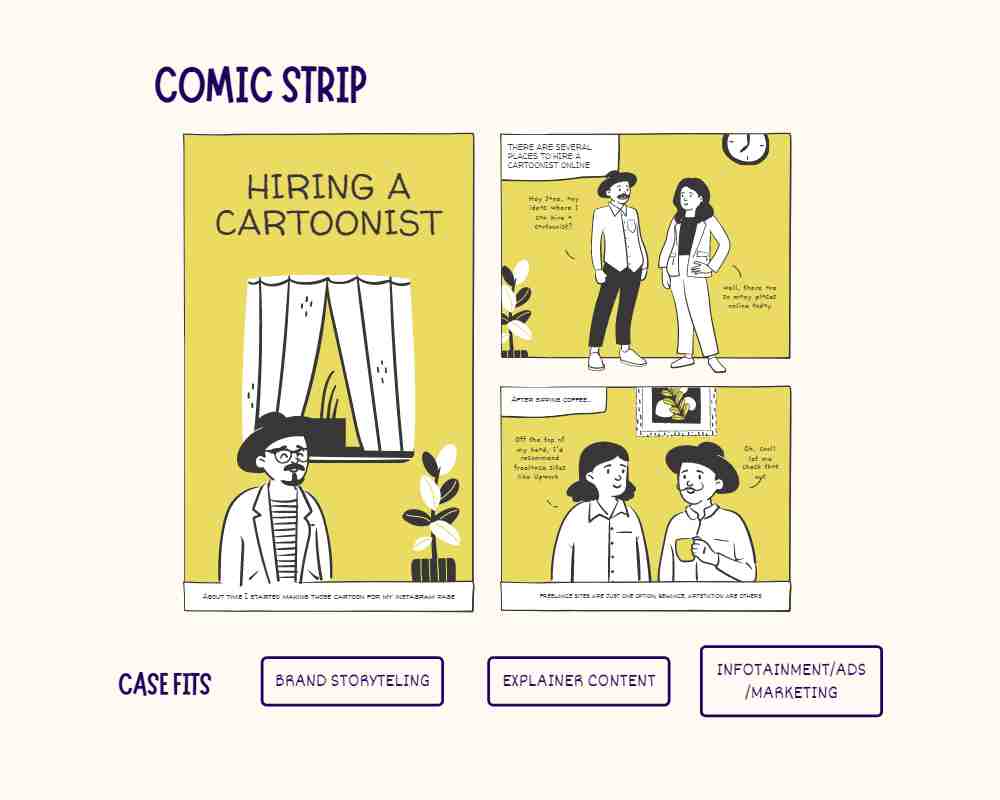
Want to tell a story with cartoons? You get a comic strip for that. Comic strips are extended variants of the typical editorial cartoon. They have several panels (pieces) joined together to create a strip, that is a collection or series of correlated cartoons.
Unlike political cartoons, however, which basically exist for driving political points, comic strips can be adapted to serve whatever purpose. Humor, education, infotainment, entertainment, you name it. Comic strips contain both text and images with more text than you’d find on practically any other type of cartoon.
What’s it good for
- Brand storytelling
- Explainer content
- Marketing and advertorial content
- Infotainment and education content
Animated cartoons
When you stitch together several bits of cartoon frames and play them over in a way that simulates movement, you get animated cartoons. If that sounds confusing, just remember that all the cartoons you watched on Nickolodeon or CN are animated cartoons.
Animated cartoons can be hand-drawn, as was the case with most Disney titles in the late 1990s or computed drawn as are most cartoons existing today. They’re the only form of cartoons incorporating voice as opposed to text.
What is it good for
- Education
- Infotainment and entertainment
- Brand storytelling
- Advertisement and marketing campaigns
- Brand awareness
Where to find cartoonists
Unlike, say, manga artists, there’s no shortage of cartoonists available for hire online. You just need to look in the right places to find the right talent for your needs. I say online, but another good way of latching on to a skilled cartoonist is via recommendations from people offline. However, that only works if you have a sprawling network of content creators who frequently require the services of cartoonists.
In this piece, we’ll be focusing more on the online cartoonist marketplaces, specifically, freelance sites like Upwork and Fiverr, portfolio sites like Behance/Dribbble and independent marketplaces like Artstation.
Hiring a cartoonist from freelance websites like Fiverr and Upwork
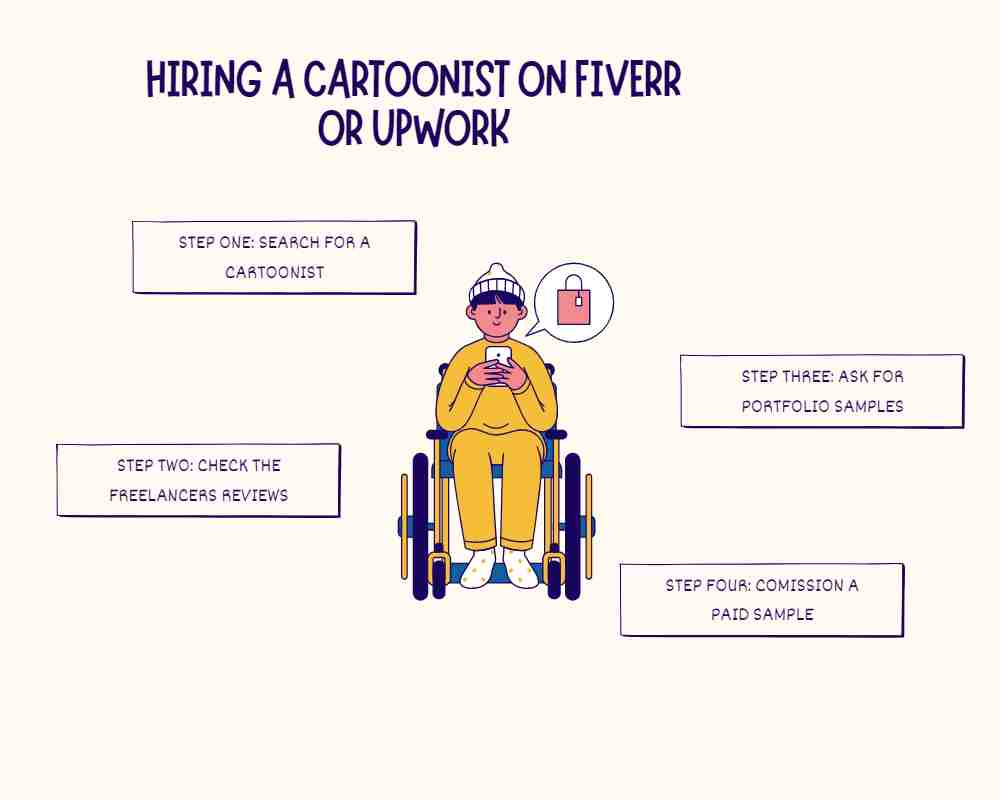
Both Upwork and Fiverr have dedicated subcategories for cartoonists, so there’s a relatively large selection of talent available for hire. To make sure you’re connecting with the best cartoonists on these platforms for your needs, follow these steps
Step one – search for a cartoonist
Both Upwork and Fiverr have sophisticated search functions that bring up only freelancers with a high-performance rating. When you search, the resulting freelancer list is a ranked list based on a freelancers’ relevance to your search and their performance over time.
Feel free to be as specific as possible. It’s okay to search for something in the lines of political cartoonist or political cartoonist black and white.
Alternatively, you could post a job offer. Both platforms (Upwork – post a job; Fiverr – Buyers’ request) allow you to submit a custom job offer to which freelance cartoonists can apply to. Job offers are usually ideal if you have a specific requirement or if you’re searching for a particular style of cartoon.
Unlike the search function, however, there’s no active performance filter, so you get applications from a broad spectrum of freelance cartoonists, of which some might be unskilled.
Whether through search or posting a job, you’ll eventually end up with a list of freelance cartoonists. Now’s it on to making a pick.
Step two – check their reviews
Fiverr and Upwork allows past clients to drop public reviews. You can use these reviews to gauge everything from the cartoonist’s skill to their communication skills. Reviews can, however, be faked, especially on Fiverr. To objectively assess freelancer reviews on both Upwork and Fiverr without getting tricked, here’s what you need to do;
Ignore the five-star reviews altogether
Virtually all the cartoonists you’ll reach via search will have an excess of five-star reviews, and most five-star reviews tell the same story – the cartoonist is great. If they’re coming through search, you already know this.
Assess the less than five-star reviews
These are more likely to point salient truths about the cartoonist, some of which you might consider valuable. For instance, if you’re searching for a purely black and white comic strip and a couple reviews subtly hint that the cartoonists was better with colored panels than B/W, then that could be a dealbreaker.
Count the number of reviews and check out the freelancers pricing
With numbers, the more, the merrier. With pricing, the higher the price relative to the value of the service and compared to the number of positive reviews, the better. Why so? A freelance cartoonist who offers dirt-cheap services is less likely to get negative reviews compared to someone else who charges a premium.
As a rule of thumb, you know you’ve met a skilled freelance cartoonist when they charge a premium price and have an abundance of positive reviews.
Step three – ask for portfolio samples
You want to see the work they’ve done before to check out assess their skill and also to check out their style. The ideal cartoonist has portfolio samples that give off a sense of creativity, sophistication (sometimes simple is sophisticated), and character.
Step four – commission a paid sample
This is an optional step, and most times, portfolio samples will be convincing enough in terms of quality and match to make a choice. Other times you might need to commission a sample from your preferred candidates to, you know, get an actual feel of their work.
Michael Lynch of mtlynch.io gives a detailed example of how to go about this on Upwork but to summarize, here’s what you need to do:
- Create a sample job. Anything related to the project you’re working on should work.
- Assign that sample cartoon task to your select cartoonists – those who’ve scaled the review and portfolio assessment phase.
- Compare each cartoon to see which one impresses you the most.
- Viola, hire the cartoonist behind that piece.
That’s basically all you need to do to land the best fit cartoonist for your needs on Fiverr or Upwork. Of course, like I said, the paid commission step is optional – most times, I don’t do it, and I certainly won’t recommend it if you’re working on a budget. Still, it’s a great way to do a demo run of the sort so you can be sure of the result you’ll get. It’s pretty helpful if you’re working on a large project with little to no room for mistakes.
The advantages of hiring a cartoonist from freelance sites like Fiverr and Upwork
It’s relatively cheaper
Competition on freelance sites among cartoonists is fierce, and that works to drive down average prices. This is especially true for Fiverr (not so much for Upwork), but you’ll need to be careful with the cheaper cartoon services – you mostly get what you pay for.
It’s easier to find a cartoonist matches your requirements
Either through search or via posting a job ad, you’re more likely to find a cartoonist who meets all your criteria and is, perhaps more importantly, available to work. As we will soon see with portfolio sites or marketplaces, you might find an ideal cartoonist, but they might not be taking any commissions.
It’s easier to hire a cartoonist
Hiring is easier on freelance sites like Fiverr and Upwork too. Unlike portfolio sites where cartoonists are mostly showing off their work, every cartoonist you’ll meet on Upwork or Fiverr is looking for work. These platforms also come with built-in functions (contracts, delivery countdowns) to make the hiring process as smooth as is possible.
The drawbacks
You need to be careful not to fall into the hands of hacks
The extremely low prices, especially on a place like Fiverr, can be tempting, and first-timers fall for it. Except a cartoonist wows you in terms of their portfolio, reviews, and maybe paid commission, you shouldn’t hire them because they’re the cheapest cartoonist available.
Hiring a freelancer on portfolio sites like Behance and Dribbble
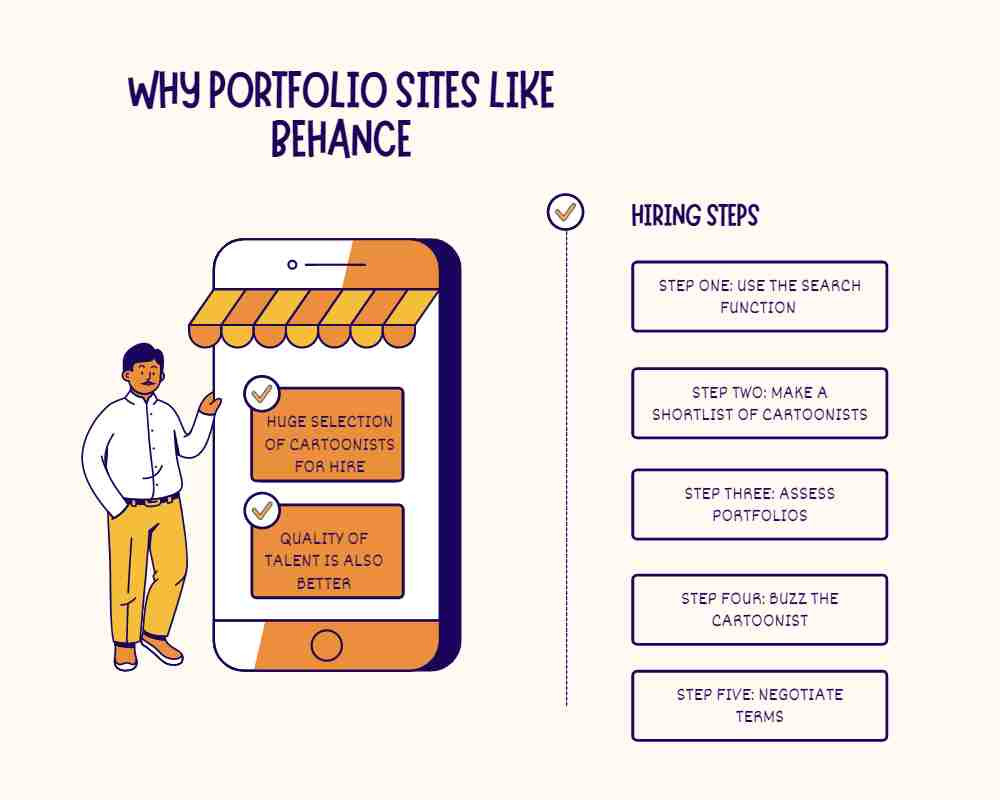
Portfolio sites are, you guessed it, where artists hang out to showcase their talent. This makes them the perfect talent hunting ground. Finding someone on a portfolio site who’s well suited to your needs is easier because you see the cartoon first before the cartoonists behind them, which is the direct opposite on a freelance site where you see the artist first before their portfolio.
Here’s how to go about finding a cartoonist on either Behance or Dribbble
Step one – use the search function
Type in whatever cartoon related keyword into the search bar of any of these sites, and you should get results matching that query. You want to be specific but not that specific, so black and white cartoonist works well, but something in the lines of black and white political cartoonist would be overkill.
Step two – make a shortlist of cartoonists
From the search results, note cartoons that strike your fancy in a preliminary shortlist.
Step three – assess portfolios
Click on the cartoons, and you should see a link to the creators’ profile page at the top left corner. Click on that link to assess the cartoonist’s full portfolio. Unlike Fiverr or Upwork, where you have to request a portfolio for viewing, Behance/Dribbble are portfolio sites themselves, so no need to contact the cartoonist just yet.
Both don’t host reviews, so you’ll need to make your judgement based on the portfolio samples. Alternatively, you can ask the cartoonist if they have a profile on a professional freelance site then take it up from there.
Step four – buzz the cartoonist
See what you like? Simply click the message button on the top right corner, and that should bring up a message panel through which you can reach out to the cartoonists. Pro-tip; great cartoonists get tons of these messages regularly; keep your message short and to the point.
Sample Behance first contact message
At this stage, and depending on who replies, you should’ve zeroed in on one, maybe two preferred artists. I say depending on who replies because not all cartoonists you reach out to will reply to your message. But don’t worry, there’s plenty of fish in the sea for that to make any significant difference.
Step five – get a reply and negotiate the terms
Once you’ve established contact, it’s then about outlining your requirements and negotiating a pay rate. On Behance and Dribbble expect cartoonists to charge premium rates. Make sure you’re as descriptive and explicit as can be; sometimes, providing a preliminary sketch works just fine.
Step six – finalizing the deal
Once the requirements, payment and delivery timetable is well understood by both parties, it’s time to sign a contract. Your contract should list all you’ve negotiated with the cartoonist including the requirements, the pay rate, the delivery schedule and, very importantly, the copyrights for the piece they’ll create. I talk more about copyrights later in this piece.
The advantages of hiring a cartoonist through Behance or Dribbble
There’s a huge selection of talent
Behance, for instance, is home to well over 10,000 Creatives. Plus, it’s easier to find the talent you want because you sort through search results based on portfolio samples rather than freelance profiles.
You get to meet some big shots in the industry
Virtually every cartoonist has a portfolio profile. Not every cartoonist has a professional freelance profile. Some might run their business personally through a personal website. Portfolio sites grants you reach to a more diverse talent pool that includes some top cartoonists who don’t bother to set up shop on a freelance website.
The drawbacks
It can be expensive
Especially if you’re dealing with top talent. On portfolio sites, cartoonists set their rates without considering any external factors. It’s very unlikely that you’d see anyone offering the $5 cartoon service obtained on Fiverr.
Hiring is not straightforward
While it’s easier to find someone who fits your needs, there’s no guarantee that they’d reply to your request for a collaboration. Freelance sites allow you to place an order immediately, sometimes without consulting the cartoonist, although I advise against that anyway.
The work experience might not be professional
Portfolio sites are stock full of talented individuals, but there’s no saying how they handle the professional aspect of collaboration. And because these sites don’t have a review system in place, it’s difficult to gauge this from the outside. It doesn’t always happen but expect some form of poor communication, late deliveries and the likes.
Hiring a cartoonist on marketplaces like Artstation
ArtStation is a marketplace, so it’s more oriented towards buying artwork (including cartoons) than it is about meeting creatives. Nevertheless, you can still meet a good selection of cartoonists on Artstation and because most cartoonists here have commercial work, the talent quality is surprisingly good.
Step one – search for a cartoonist
ArtStation has three subcategories, namely digital art, print shop and studios. Each of them is searchable on its own, but it’s better to do a general search. Artstation doesn’t have a talent pool that’s as expansive as the other options in this cartoonist hiring guide, so you need to broaden your search keywords – cartoon or something like 2D cartoon will do just fine.
Step two – create a shortlist
From the results page, make a shortlist of cartoons that appeal to you to avoid getting lost in the sea of search results.
Step three – assess portfolios
Click on the cartoons in your shortlist, and that should take you to the full view page. Navigate to the author’s profile by clicking the author name in the top left corner and then move on to their portfolio by selecting the portfolio tab. Check the samples available there to see if they resonate with what you’re looking for.
Step four – send a message
Artstation allows you to send a direct message to cartoonists from their profile page by clicking the message button. You’ll need an Artstation account to do this. As was the case with cartoonists on portfolio sites, you want to keep your message short and simple. Introduce yourself, state what you want done and leave it at that.
Step five – negotiate terms
From the responses you get, you should’ve made your final shortlist. Now’s the time to finalize the project details, pay rate and everything else. It’s important that the cartoonist understands exactly what you want. Sometimes words might not suffice to make the description, so feel free to draft up sketches.
Step six – finalize the deal
Get a contract set up using the requirements and payment plan agreed upon by both parties. Your contract should be as explicit as possible. Make sure to include all relevant details regardless of how trivial it may seem, and make sure to clarify who owns the copyrights for the piece (more on this later).
The advantages of using Artstation to hire a cartoonist
It’s a professional site with professional artists
Most of the talent you’ll find on Artstation are seasoned professionals who’re well-grounded in the etiquettes and business of professional collaborations. That’s compared to portfolio sites like Dribbble.
You’re more likely to get a response
Again, compared to portfolio site cartoonists, you’re more likely to get a response for your request with cartoonists on Artstation.
The drawbacks
The talent pool is smaller
Compared to the other two options for hiring a cartoonist, Artstation has a smaller number of qualified cartoonists. One reason for this is the site’s relatively new and still growing. Another reason is its talent are mainly of the professional crop.
It can be expensive
Professional cartoonists mean very professional rates, certainly none of that $5 stuff you’d get on freelance websites.
Which method is the best for hiring a cartoonist?
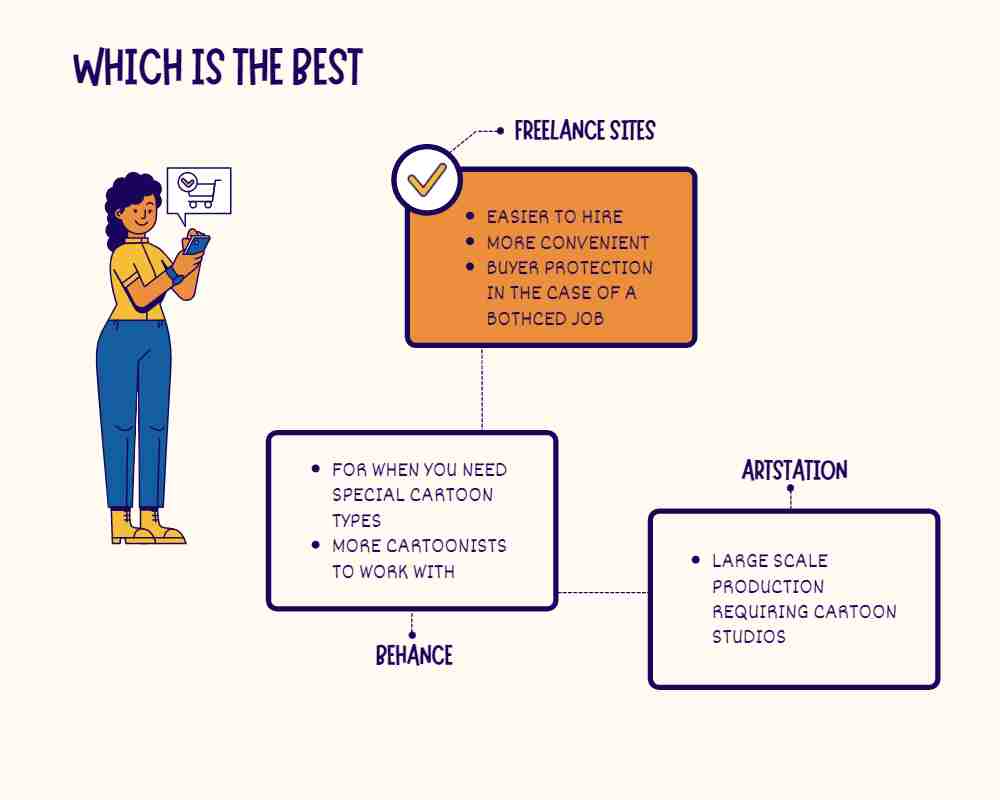
All things considered, the freelancing route is the best way to hire a cartoonist simply for the flexibility, reliability and ease of hiring compared to the other options.
Portfolio sites like Behance and Dribbble are ideal when you’re looking for a particular creative style or talent. It’s easy to sort through talent on there, but you’ll have to deal with the sometimes low response rates.
I rarely use Artstation for hiring cartoonists, but I’ve come to see that the platform has a better selection of 3D cartoonists(and studios), the kind you’ll need if you want to produce an animation, for instance. If that’s what you’re looking for, it makes sense to start your search there.
Finishing up hiring
I’ve already covered the major steps to take when you need to hire a cartoonist; however, there are a few extra things to note.
What to look out for in the ideal portfolio sample of a cartoonist
Creative flair
How captivating is the cartoon? Does it evoke imagery or an idea? And how does it manage to evoke this imagery – is it through simplicity or through a style you’ve never seen before? Both are good, but the latter is a better indicator of creativity.
Passion
A cartoonist who’s passionate about their work will go to extra lengths to make them stand out. How distinctive is the cartoon from your everyday cartoon piece? Note that distinction can be achieved by being simple or sophisticated with their style—both work.
Attention to detail
Attention to even minute details is a sure-fire way to assess the skill and dedication of a cartoonist. Usually, this is something that meets the eye when you view a cartoon artwork, but for brevity – how’s the finishing on the piece? How detailed is the piece, and how detailed is the detailing on the piece?
The creative flair, passion and attention to detail triangle of assessment is an objective way to qualify a cartoonist. Of course, it still boils down to your needs and your taste, and most times, all of this is apparent from just looking at the portfolio work. No need to brainstorm or get all granular.
Interviewing a cartoonist
Except you’re hiring a cartoonist to commission a significantly large piece (large in terms of financial cost and effort it’ll take), or you plan on staffing a long term cartooning role, I don’t really advise scheduling an interview.
Much of what you’ll need to score a cartoonist is already available from their portfolio and reviews (if you’re sourcing from a freelance site). If your case is the former, here’s a sample way to interview a cartoonist for hire.
Step one – schedule the interview
Interviews should be at times convenient for both you and the cartoonist. It makes sense to pay them for the time they spend on the interview too – interviews are considered part of consultation. The best cartoonists won’t give off hours of their time for free anyway.
Step two – describe your requirements
This is something you should’ve done on your first contact with the cartoonist. The motive for doing it this time is, however, different. You want the cartoonist to not just understand what you need done (which is the case on first contact) but also to present how they’d go about completing the task.
Step three – ask them to describe how they’ll complete the project
Pay attention to their description. Does it make sense? Does it feel like the best possible way of fulfilling your needs? If you’re not quite sure of the cartoon style you want and they suggest creating one or two test panels, that makes sense as opposed to convincing you that a particular style is the best for you, for instance. How good were they at communicating their solution?
The goal here is not to assess the skill and expertise of the cartoonist; you should be well over that at this point. What you want to know is how much of a perfect fit they are for your project. How would collaborating with them pan out – listening to their pitch gives you an overall and, in my experience, relatively accurate prediction.
A note on copyrights
I’ll start by saying if you’re embarking on a large project, it pays to hire a copyright lawyer to draft up a copyright document. Copyright laws can be very complex, and sometimes things are not as straightforward as they may seem.
If you’re working on a small project, then these tips should help protect your interests as far as it concerns copyrights.
Negotiate a copyright agreement before signing the contract
Who owns the cartoon piece? Who own the copyrights to the piece? Is the cartoonist allowed to share, use or distribute the cartoon? Are you allowed to share or distribute the piece for commercial purposes? All these questions should be answered, and ideally, you want full copyright ownership of the cartoon piece with legal rights to share and distribute it as you please.
Create a copyright document
Create a copyright document with the negotiated answers to these questions and make sure all concerned parties sign off on it. If you’re working with a team of cartoonists, each contributing member should be included as a signatory.
Secure the document for future purposes
That’s pretty much self-explanatory.
Conclusion
I know, I know, this is a long read, but if you’re serious about hiring a skilled cartoonist that matches your needs, then it’s a well worth read. Overall, and as a way of ending, I’ll say trust your guts when trying to hire a cartoonist. If they tick all the checkboxes but don’t just feel right, you’re better off seeking another candidate and taking it from there.
